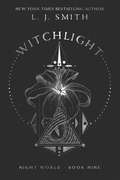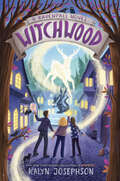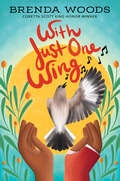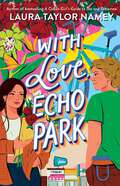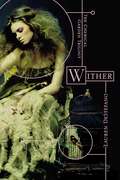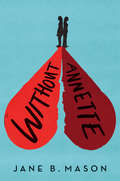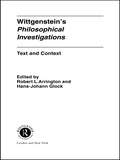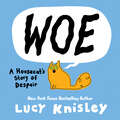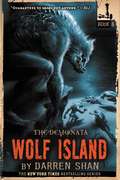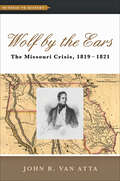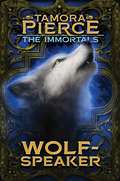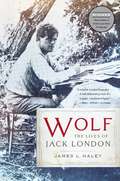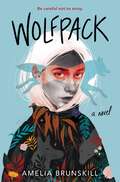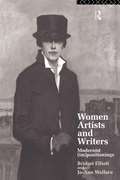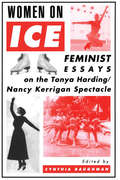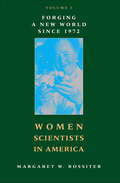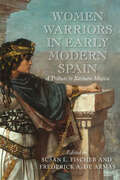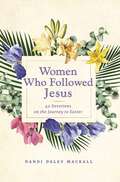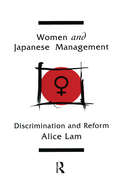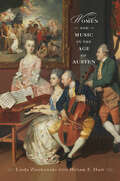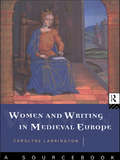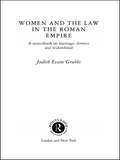- Table View
- List View
Witchlight: Night World; Daughters Of Darkness; Spellbinder; Dark Angel; The Chosen; Soulmate; Huntress; Black Dawn; Witchlight (Night World #9)
by L.J. SmithThe ninth book in L.J. Smith’s beloved bestselling Night World series is now available as a special collector’s edition!Keller, a shapeshifter, has been chosen to protect a new Wild Power. When she’s not a panther, Keller is a tough, no-nonsense seventeen-year-old. But she meets her match in Iliana Harman—a clueless blonde who may really be the legendary Witch Child. Will Keller get annoyed and kill her before she can convince her to join Circle Daybreak? And what about the dashing and romantic Galen? Keller is falling in love with him—but he’s destined to be the Witch Child’s soulmate.
Witchwood: A Ravenfall Novel (Ravenfall #3)
by Kalyn JosephsonThe third book in the &“spellbinding&” (Kirkus Reviews) Ravenfall series follows Anna and Colin, two kids with supernatural powers, into the magical town of Witchwood, where local witches have gone missing—and Anna might be next.Everything is changing at Ravenfall, the magical inn that best friends Anna Ballinkay and Colin Pierce call home. The leaves are turning golden, the air is as crisp as a harvest apple, and Anna&’s older twin sisters are leaving for college… but at least Anna and Colin have finally reunited after a summer apart, just in time for a new magical mission.When their mission is interrupted by a mysterious attack that forces them to seek shelter, Anna and Colin head to Witchwood, a spooky lakeside town where magic doesn&’t have to be hidden. Anna is excited to reunite with her aunt and cousin, who she hopes might teach her more about Jewish magic—except her cousin seems to hate her. Especially once Anna realizes that she&’s a witch, just like them.But rude cousins are the least of their problems, because they soon discover that witches are going missing in Witchwood. And if Anna and Colin can&’t stop whatever sinister force is making them disappear, Anna could be the next target…
With Just One Wing
by Brenda WoodsCoretta Scott King Honor winner Brenda Woods&’s poignant, heartfelt story of an adopted boy and the bird he rescuesEveryone expects Coop to be musical like his beloved parents, but he&’s not. That&’s one of the few things he finds awkward about being adopted—well, that and the fact that he sometimes wonders why his birth mother didn&’t love him enough to keep him. This summer, he&’s stuck at home with a broken arm after falling out of a tree trying to get a closer peek at a mockingbird nest. Later, when the eggs in the nest have hatched and the fledglings fly away, he and his friend Zandi notice that one of them stays behind. Taking a closer look, they realize the bird only has one wing. Since it won&’t survive in the wild, they adopt it and name it Hop, and then learn everything they can about birds so they can care for Hop properly. Unfortunately, when a hawk injures Hop, the vet says it&’s illegal to keep mockingbirds as pets. Faced with a difficult decision about surrendering his beloved little bird to a bird sanctuary, Coop starts thinking about his birth mother&’s motivation in a new light.
With Love, Echo Park
by Laura Taylor NameyFrom the New York Times and internationally bestselling author of A Cuban Girl&’s Guide to Tea and Tomorrow, this novel follows two Cuban teens in LA&’s Echo Park neighborhood who clash over their visions for the future, the secrets between their families…and the sparks flying between them.Seventeen-year-old Clary is set to inherit her family&’s florist shop, La Rosa Blanca—one of the last remnants of the Cuban business district that once thrived in Los Angeles&’s Echo Park neighborhood. Clary knows Echo Park is where she&’ll leave a legacy, and nothing is more important to her than keeping the area&’s unique history alive. Besides Clary&’s florist shop, there&’s only one other business left founded by Cuban immigrants fleeing Castro&’s regime in the sixties and seventies. And Emilio, who&’s supposed to take over Avalos Bicycle Works one day, is more flight risk than dependable successor. While others might find Emilio appealing, Clary can see him itching to leave now that he&’s graduated, and she&’ll never be charmed by a guy who doesn&’t care if one more Echo Park business fades away. But then Clary is caught off guard when an unexpected visitor delivers a shocking message from someone she thought she&’d left behind. Meanwhile, Emilio realizes leaving home won&’t be so easy—and Clary, who has always been next door, is who he confides in. As the summer days unfold, they find there&’s something stronger than local history tying them together.
Wither (The Chemical Garden Trilogy #1)
by Lauren DeStefanoWhat if you knew exactly when you&’d die? The first book of The Chemical Garden Trilogy.By age sixteen, Rhine Ellery has four years left to live. A botched effort to create a perfect race has left all males born with a lifespan of 25 years, and females a lifespan of 20 years—leaving the world in a state of panic. Geneticists seek a miracle antidote to restore the human race, desperate orphans crowd the population, crime and poverty have skyrocketed, and young girls are being kidnapped and sold as polygamous brides to bear more children. When Rhine is sold as a bride, she vows to do all she can to escape. Yet her husband, Linden, is hopelessly in love with her, and Rhine can&’t bring herself to hate him as much as she&’d like to. He opens her to a magical world of wealth and illusion she never thought existed, and it almost makes it possible to ignore the clock ticking away her short life. But Rhine quickly learns that not everything in her new husband&’s strange world is what it seems. Her father-in-law, an eccentric doctor bent on finding the antidote, is hoarding corpses in the basement; her fellow sister wives are to be trusted one day and feared the next; and Rhine has no way to communicate to her twin brother that she is safe and alive. Together with one of Linden's servants, Gabriel, Rhine attempts to escape just before her seventeenth birthday. But in a world that continues to spiral into anarchy, is there any hope for freedom?
Without Annette
by Jane B. MasonA gorgeously written, witty, and poignant YA novel, about a girl who must forge her own path in the wake of a crumbling relationship.Josie Little has been looking forward to moving halfway across the country to attend Brookwood Academy, a prestigious boarding school, with her girlfriend, Annette, for ages. But underneath Brookwood's picture-perfect image lies a crippling sense of elitism that begins to tear the girls apart from the moment they arrive.While Josie struggles to navigate her new life, Annette seems to fit in perfectly. Yet that acceptance comes with more than a few strings. And consequently, Annette insists on keeping their relationship a secret. At first, Josie agrees. But as Annette pushes her further and further away, Josie grows closer to Penn, a boy whose friendship and romantic feelings for her tangle her already-unraveling relationship. When Annette's need for approval sets her on a devastating course for self-destruction, Josie isn't sure she can save her this time-or if Annette even wants her to try.
Wittgenstein's Philosophical Investigations: Text and Context
by Hans-Johann Glock Robert L. ArringtonFirst published in 1992. Routledge is an imprint of Taylor & Francis, an informa company.
Woe: (A Graphic Novel)
by Lucy KnisleyWOE! SCREAM! MEOW! ...PURR? Join the hilarious and of course dramatic world of Linney the House Cat, as her webcomic antics are gathered into graphic novel for the very first time! This collection is perfect for cat lovers and Linney fans alike.What if our cats could talk? Would they ask endless questions about why we haven't given them wet food...again? Would they scream greetings at the first sign of life before the sun even rises? Linney certainly will. Have you met Linney yet? If not, prepared to be blessed! Lucy Knisley's online Linney comics are collected for the very first time in this gifty hardcover featuring the internet sensation, Linney. With all-new comics, this collection shows us just how amazing, and what a true gift, all cats are.
Wolf Island: The Demonata Book 8 (The Demonata #8)
by Darren ShanAs the mysterious Shadow builds an army of demons, Grubbs Grady and his team search desperately for answers. But when they follow up a new lead, it takes them to an old, unexpected foe - the Lambs. "We spot the werewolves as we skim the treetops. Mutated, vicious, hairy monstrosities, all fangs, claws and muscles. The beast within me tries to force its way to the surface, howling silently at its warped brethren. I've never rid myself of the wolf..."
Wolf by the Ears: The Missouri Crisis, 1819–1821 (Witness to History)
by John R. Van Atta“In this engaging work, Van Atta . . . provides an in-depth analysis of the 1820 Missouri Compromise, a seminal event on the road to the Civil War.” —ChoiceIn Wolf by the Ears, John R. Van Atta discusses how the question of slavery surfaced in the divisive fight over Missouri statehood. As Thomas Jefferson wrote at the time, a nation dealing with the politically implacable issue of slavery essentially held the “wolf” by the ears—and could neither let go nor hang on forever. The first organized Louisiana Purchase territory to lie completely west of the Mississippi River and northwest of the Ohio, Missouri carried special significance for both pro- and anti-slavery advocates. Northern congressmen leaped out of their seats to object to the proposed expansion of the slave “empire,” while slave-state politicians voiced outrage at the northerners’ blatant sectional attack. Although the Missouri confrontation ultimately appeared to end amicably with a famous compromise that the wily Kentuckian Henry Clay helped to cobble together, the passions it unleashed proved vicious, widespread, and long lasting.Van Atta deftly explains how the Missouri crisis revealed the power that slavery had already gained over American nation building. He explores the external social, cultural, and economic forces that gave the confrontation such urgency around the country, as well as the beliefs, assumptions, and fears that characterized both sides of the slavery argument. Wolf by the Ears provides students in American history with an ideal introduction to the Missouri crisis while at the same time offering fresh insights for scholars of the early republic.“Van Atta has written the clearest narrative of the Missouri crisis to date.” —Louisiana History
Wolf by the Ears: The Missouri Crisis, 1819–1821 (Witness to History)
by John R. van Van AttaHow bitter infighting over the expansion of slavery in western territories almost destroyed the fragile United States.From the early days of the republic, American leaders knew that an unpredictable time bomb—the question of slavery—lay at the heart of national politics. An implicit understanding between North and South helped to keep the issue at bay: northern states, where slavery had been set on course for extinction via gradual emancipation, tacitly agreed to respect the property rights of southern slaveholders; in return, southerners essentially promised to view slaveholding as a practical evil and look for ways to get rid of it. By 1819–1820, however, westward expansion had brought the matter to a head. As Thomas Jefferson wrote at the time, a nation dealing with the politically implacable issue of slavery essentially held the "wolf" by the ears—and could neither let go nor hang on forever.In Wolf by the Ears, John R. Van Atta discusses how the sectional conflict that led to the Civil War surfaced in the divisive fight over Missouri statehood. The first organized Louisiana Purchase territory to lie completely west of the Mississippi River and northwest of the Ohio, Missouri carried special significance for both pro- and anti-slavery advocates. Northern congressmen leaped out of their seats to object to the proposed expansion of the slave "empire," while slave-state politicians voiced outrage at the northerners’ blatant sectional attack. Although the Missouri confrontation ultimately appeared to end amicably with a famous compromise that the wily Kentuckian Henry Clay helped to cobble together, the passions it unleashed proved vicious, widespread, and long lasting.Van Atta deftly explains how the Missouri crisis revealed the power that slavery had already gained over American nation building. He explores the external social, cultural, and economic forces that gave the confrontation such urgency around the country, as well as the beliefs, assumptions, and fears that characterized both sides of the slavery argument. Wolf by the Ears provides students in American history with an ideal introduction to the Missouri crisis while at the same time offering fresh insights for scholars of the early republic.
Wolf-speaker: Wild Magic; Wolf-speaker; Emperor Mage; The Realms Of The Gods (The Immortals #2)
by Tamora PierceDaine&’s magic must save her friends—both wolf and human—in this second book of the Immortals series, featuring an updated cover for longtime fans and fresh converts alike, and including an all-new afterword from Tamora Pierce.When Daine is summoned to help a pack of wolves—dear friends from her old village—she and Numair travel to Dunlath Valley to answer the call. But when they arrive, Daine is shocked to learn that it’s not only animals whose lives are threatened; people are in danger, too. Dunlath’s rulers have discovered black opals in their valley. They’re dead set on mining the opals and using the magic contained in the stones to overthrow King Jonathan. Even if it means irreversibly damaging the land—and killing their workers. Daine must master her wild magic in order to save both her animal friends and her human ones.
Wolf: The Lives of Jack London
by James L. HaleyAward-winning western historian James L. Haley paints a vivid portrait of Jack London?adventurer, social reformer, and the most popular American writer of his generation
Wolfpack
by Amelia BrunskillThis shocking, suspenseful novel about a group of teenage girls living in a cult reveals the terrifying paranoia and suspicion that emerges when one of them goes missing– perfect for fans of We Were Liars. Nine girls bound together in beautiful, virtuous Havenwood, a refuge from an unsafe world. Then there are eight one of them gone — departed with no warning. Did this member of their pack stray willingly, or did something more sinister occur? The girls seek answers not knowing if they should be angry or frightened or perhaps, they should be both.
Women Artists and Writers: Modernist (Im)Positionings
by B. J. Elliott Jo-Ann WallaceIn this beautifully illustrated and provocative study, Bridget Elliott and Jo-Ann Wallace reappraise women's literary and artistic contribution to Modernism. Through comparative case studies, including Natalie Barney, Virginia Woolf, Vanessa Bell and Gertrude Stein, the authors examine the ways in which women responded to Modernism and created their artistic identity, and how their work has been positioned in relation to that of men. Bringing together women's studies, visual arts and literature, Women Writers and Artists makes an important contribution to 20th century cultural history. It puts forward a powerful case against the academic division of cultural production into departments of Art History and English Studies, which has served to marginalize the work of female Modernists.
Women On Ice: Feminist Responses to the Tonya Harding/Nancy Kerrigan Spectacle
by Cynthia BaughmanThe attack on Nancy Kerrigan at the 1994 U.S. Figure Skating Championships set the stage for a Winter Olympics spectacle: Tonya versus Nancy. Women on Ice collects the writings of a diverse group of feminists who address and question our national obsession with Tonya and Nancy and what this tells us about perceptions of women in twentieth century America.
Women Scientists in America: Forging a New World since 1972
by Margaret W. RossiterThe third volume of Margaret W. Rossiter’s landmark survey of the history of American women scientists focuses on their pioneering efforts and contributions from 1972 to the present. Central to this story are the struggles and successes of women scientists in the era of affirmative action. Scores of previously isolated women scientists were suddenly energized to do things they had rarely, if ever, done before—form organizations and recruit new members, start rosters and projects, put out newsletters, confront authorities, and even fight (and win) lawsuits. Rossiter follows the major activities of these groups in several fields—from engineering to the physical, biological, and social sciences—and their campaigns to raise consciousness, see legislation enforced, lobby for passage of the Equal Rights Amendment, and serve as watchdogs of the media. This comprehensive volume also covers the changing employment circumstances in the federal government, academia, industry, and the nonprofit sector and discusses contemporary battles to increase the number of women members of the National Academy of Science and women presidents of scientific societies. In writing this book, Rossiter mined nearly one hundred previously unexamined archival collections and more than fifty oral histories. With the thoroughness and resourcefulness that characterize the earlier volumes, she recounts the rich history of the courageous and resolute women determined to realize their scientific ambitions.
Women Scientists in America: Forging a New World since 1972
by Margaret W. RossiterThis survey of female scientists in recent American history “offers compelling data alongside the multiple stories of individual women” (Science).The third volume of Margaret W. Rossiter’s landmark survey of the history of American women scientists focuses on their pioneering efforts and contributions from 1972 to the present. Central to this story are the struggles and successes of women scientists in the era of affirmative action. Scores of previously isolated women scientists were suddenly energized to do things they had rarely, if ever, done before—form organizations and recruit new members, start rosters and projects, put out newsletters, confront authorities, and even fight (and win) lawsuits. Rossiter follows the major activities of these groups in several fields—from engineering to the physical, biological, and social sciences—and their campaigns to raise consciousness, see legislation enforced, lobby for passage of the Equal Rights Amendment, and serve as watchdogs of the media. This comprehensive volume also covers the changing employment circumstances in the federal government, academia, industry, and the nonprofit sector and discusses contemporary battles to increase the number of women members of the National Academy of Science and women presidents of scientific societies.In writing this book, Rossiter mined nearly one hundred previously unexamined archival collections and more than fifty oral histories. With the thoroughness and resourcefulness that characterize the earlier volumes, she recounts the rich history of the courageous and resolute women determined to realize their scientific ambitions.
Women Warriors in Early Modern Spain: A Tribute to Bárbara Mujica (Early Modern Exchange)
by Sherry Velasco Frederick A. de Armas Emilie L. Bergmann Emily C. Francomano Susan L. Fischer Marjorie Marjorie Agosín Gillian T. W. Ahlgren Isaac Benabu Edward H. Friedman Charles Victor Ganelin Susan Paun de García Elizabeth Cruz Petersen Teresa Scott Soufas Sharon D. VorosAlthough scholars often depict early modern Spanish women as victims, history and fiction of the period are filled with examples of women who defended their God-given right to make their own decisions and to define their own identities. The essays in Women Warriors in Early Modern Spain examine many such examples, demonstrating how women battled the status quo, defended certain causes, challenged authority, and broke barriers. Such women did not necessarily engage in masculine pursuits, but often used cultural production and engaged in social subversion to exercise resistance in the home, in the convent, on stage, or at their writing desks.Distributed for the University of Delaware Press
Women Who Followed Jesus: 40 Devotions on the Journey to Easter
by Dandi Daley Mackall"Powerful daily encouragement that will enhance your walk with God." —Jerry B. Jenkins, writer of the Left Behind series and The Chosen novelsLook with fresh eyes toward the Bible stories you have heard all your life. Contemplate, ponder, and glory at Jesus' final days on earth, his heart-wrenching death, and marvelous resurrection alongside relatable women, chosen by God to play extraordinary roles through Lent, Easter, Pentecost, and beyond! Women Who Followed Jesus honors ordinary women who were integral to declaring Christ as Messiah, serving as early church believers, and announcing Jesus as the fulfillment of Scripture. From Lent to Easter to Pentecost and beyond, these forty fresh and thought-provoking Bible-based devotions draw readers closer to the risen Savior while reminding individuals that God has a purpose for each of our lives. The struggles and joys of these women connect with everyday readers on topics such as patience, hope, faith, trust, persistence, sacrifice, grace, and love, addressing women's needs that cross generations and centuries. The story of Jesus unfolds through the voices of Mary the mother of Jesus, Mary Magdalene, Joanna, Susanna, Salome, Mary and Martha of Bethany, the Samaritan woman at the well, and others, in forty devotions: Each reading begins with a passage of Scripture. Grounded in the biblical account, readers are challenged to imagine each woman's journey toward living with a risen Jesus. Poignant questions invite daily meditation and personal reflection at the end of each day's reading. This biblical and research-based journey of the miraculous life, death, and resurrection of Jesus encourages readers to worship, grow, and submit to God's plans, offering hope to women no matter what stage of life they're in. The involvement of women in the work of Christ should be as commonly known as the story of his twelve disciples. Women Who Followed Jesus recognizes and honors the ordinary women God chose for his extraordinary purpose. Each of the daily entries offers greater appreciation of these important female voices. This spring, contemplate, ponder, and learn by using this as your Bible study and listen as women of the Bible glorify God's Divine Son, Jesus the Risen King. ECPA Easter Bestseller 2024Learn more about Women Who Followed Jesus and find free resources at womenwhofollowedjesusbook.com
Women and Japanese Management: Discrimination and Reform
by Alice C LamStandard works on the employment systems of Japanese companies deal almost exclusively with men. Women, however, constitute the vast majority of the low wage, highly flexible "non-core" employees.This book breaks new ground in examining the role of Japanese women in industry. It assesses the extent to which growing pressure for equal opportunities between the sexes has caused Japanese companies to adapt their employment and personnel management practices in recent years.The author puts the argument in an historical perspective, covering the employment of Japanese women from the start of Japan's industrialisation up to the turning point of the 1986 Equal Employment Opportunity (EEO) Law. She examines the background and execution of the legislation and she looks at the response of the business community. In her case study of the Seibu department store, which takes up the final part of the book, Lam concludes that the EEO Law has not had the desired effect.
Women and Music in the Age of Austen (Transits: Literature, Thought & Culture, 1650-1850)
by Juliette Wells Leslie Ritchie Gayle Magee Ruth Perry Pierre DuBois Kelly M. McDonald Danielle Grover Penelope Cave Simon Fleming Alison C. DeSimone Jane Girdham Jeffrey A. Nigro Devon R. NelsonWomen and Music in the Age of Austen highlights the central role women played in musical performance, composition, reception, and representation, and analyzes its formative and lasting effect on Georgian culture. This interdisciplinary collection of essays from musicology, literary studies, and gender studies challenges the conventional historical categories that marginalize women’s experience from Austen’s time. Contesting the distinctions between professional and amateur musicians, public and domestic sites of musical production, and performers and composers of music, the contributors reveal how women’s widespread involvement in the Georgian musical scene allowed for self-expression, artistic influence, and access to communities that transcended the boundaries of gender, class, and nationality. This volume’s breadth of focus advances our understanding of a period that witnessed a musical flourishing, much of it animated by female hands and voices. Published by Bucknell University Press. Distributed worldwide by Rutgers University Press.
Women and Religion in the African Diaspora: Knowledge, Power, and Performance (Lived Religions)
by R. Marie GriffithThis landmark collection of newly commissioned essays explores how diverse women of African descent have practiced religion as part of the work of their ordinary and sometimes extraordinary lives. By examining women from North America, the Caribbean, Brazil, and Africa, the contributors identify the patterns that emerge as women, religion, and diaspora intersect, mapping fresh approaches to this emergent field of inquiry.The volume focuses on issues of history, tradition, and the authenticity of African-derived spiritual practices in a variety of contexts, including those where memories of suffering remain fresh and powerful. The contributors discuss matters of power and leadership and of religious expressions outside of institutional settings. The essays study women of Christian denominations, African and Afro-Caribbean traditions, and Islam, addressing their roles as spiritual leaders, artists and musicians, preachers, and participants in bible-study groups. This volume's transnational mixture, along with its use of creative analytical approaches, challenges existing paradigms and summons new models for studying women, religions, and diasporic shiftings across time and space.
Women and Writing in Medieval Europe: A Sourcebook
by Carolyne LarringtonCarolyne Larrington has gathered together a uniquely comprehensive collection of writing by, for and about medieval women, spanning one thousand years and Europe from Iceland to Byzantiu. The extracts are arranged thematically, dealing with the central areas of medieval women's lives and their relation to social and cultural institutions. Each section is contextualised with a brief historical introduction, and the materials span literary, historical, theological and other narrative and imaginative writing. The writings here uncover and confound the stereotype of the medieval woman as lady or virgin by demonstrating the different roles and meanings that the sign of woman occupied in the imaginative space of the medieval period.Larrington's clear and accessible editorial material and the modern English translations of all the extracts mean this work is ideally suited for students. Women and Writing in Early Europe: A Sourcebook also contains an extensive and fully up-to-date bibliography, making it not only essential reading for undergraduates and post graduates but also a valuable tool for scholars.
Women and the Law in the Roman Empire: A Sourcebook on Marriage, Divorce and Widowhood (Routledge Sourcebooks for the Ancient World)
by Judith Evans GrubbsIt is widely recognized that Roman law is an important source of information about women in the Roman world, and can present a more rounded and accurate picture than literary sources. This sourcebook fully exploits the rich legal material of the imperial period - from Augustus (31 BCE - 14 CE) to the end of the western Roman Empire (476 CE), incorporating both pagan and Christian eras, and explaining the rights women held under Roman law, the restrictions to which they were subject, and legal regulations on marriage, divorce and widowhood.
